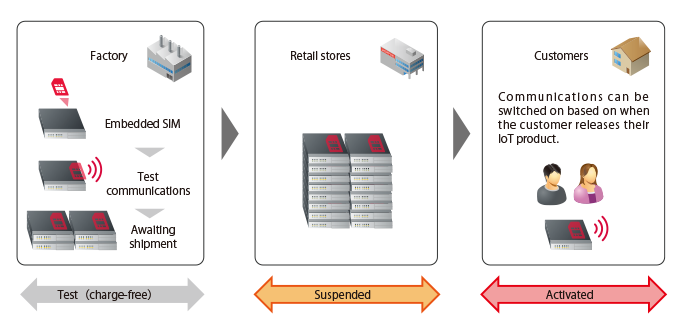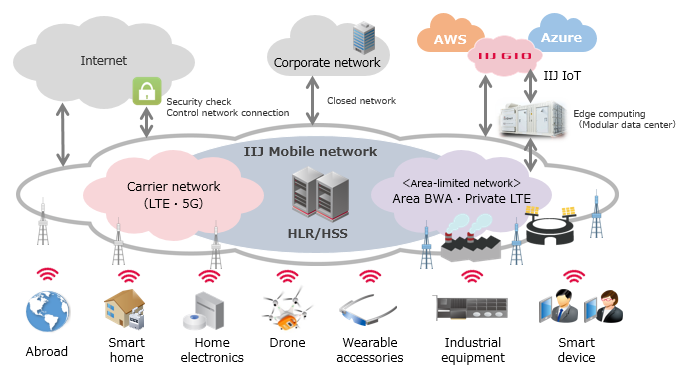Top of Page
- Links to move inside this page.
- HOME
- About IIJ
- News / CSR
- Press Releases
- 2018
- IIJ to Begin Offering "IIJ Mobile Access Service Type I" as a Full MVNO
IIJ to Begin Offering "IIJ Mobile Access Service Type I" as a Full MVNO
Providing Japan’s First Full MVNO Service Using Internal 3G/LTE Network
March 15, 2018
TOKYO-March 15, 2018-Internet Initiative Japan Inc. (IIJ, NASDAQ: IIJI, TSE1: 3774), one of Japan's leading Internet access and comprehensive network solutions providers, announced that it will offer IIJ Mobile Access Service Type I (hereafter, Type I) starting today as a full MVNO. This service will both provide a variety of plans that fit different types of usage for corporate customers and achieve more efficient communications costs for specific IoT applications.
Full MVNOs (Mobile Virtual Network Operators) are independent mobile network operators that use wireless access facilities such as bases of mobile network operator (MNOs) by owning Mobile Network Code (MNC) and International Mobile Subscriber Identity (IMSI)(*).
IIJ is Japan's first full MVNO connecting NTT DOCOMO’s 3G/LTE network by maintaining and operating its own subscriber management systems (HLR/HSS) which are part of MVNO core network infrastructure. By having IIJ's own HLR/HSS systems, IIJ is able to manage its own SIM cards and flexibly design various services.
Starting with Type I service, IIJ will be expanding service line-ups, including International roaming options and SIMs that are specialized for being built into devices (so-called "chip SIMs") by leveraging the special characteristics that come with being a full MVNO.
- (*)Mobile Network Code internationally defines mobile network operator and International Mobile Subscriber Identity defines communications users. By acquiring individual identification number, IIJ can mutually connect mobile network operators within and outside Japan.
Service Highlights
"SIM Life Cycle Management" to streamline SIM's management
"SIM Life Cycle Management" allows a more efficient way of handling SIM maintenance fees by activating and suspending SIM cards. Users can freely switch the status of SIMs from/to activated and suspended. SIM's monthly communications fee is free before activation and when in a suspended its fee is reduced. This is extremely effective for example when customers are dealing with IoT products; when SIMs are in inventory, their status can be suspended and avoid being used in unauthorized and unnecessary ways and also limit the transmission cost component of IoT product life cycle costs.
A variety of plan types to meet customer's usage needs
Type I offers a range of different plan types, including the packet share plan that allow customers to select data transmission volume and subscription models (change to usage based plans, switch over to low speed transmissions, or stop data transmissions) at any time through a web service online, upload priority plans that do not limit upload volumes for devices such as security cameras (transmissions from customer devices to the Internet), and even plans that allow each to have an IP address type (network type) designated by the customer.
SIM management functions via service online and API
Users are able to use SIM Life Cycle Management, acquire SIM information, and order additional SIMs through web service online and by cooperating API. This let monthly communications fee to be reduced by controlling the status of SIM by activating SIM upon when the product is sold. Moreover these functions are very efficient in managing inventory and operation of SIM.
- -- Usage Scenarios A for SIM Life Cycle Management --
- In cases in which users are manufacturing and distributing IoT products that include SIMs, users can set the SIMs to a suspended status during the period from which the IoT product is shipped until it is sold. End users can activate the SIM when they launch these devices and start transmitting data.
-

- -- Usage Scenarios B for SIM Life Cycle Management --
- In cases in which users apply IoT to the agriculture industry (e.g., when automatically managing water levels in rice paddies), users can limit their transmission maintenance administration fees by setting the transmission state to "suspended" during seasons in which water management is not necessary.
-

Service Details
- 1)Plans
-
- Users may choose either a fixed plan or a packet sharing plan.
- Fixed plan
This plan provides a fixed data transmission capacity per line. If this fixed transmission capacity is exceeded, the line switches to 256 kbps. Unused transmission capacity can be carried over into the following month. - Packet sharing plan
This plan allows users to share a set data transmission capacity among multiple lines. If the contracted transmission capacity is exceeded, users may choose from the following three options for handling the line:- Packet Pack A:
- When the contracted capacity is exceeded, data transmissions cease.
- Packet Pack B:
- When the contracted capacity is exceeded, transmissions speeds slow to 256 kbps.
(*)Packet Pack B is available starting at 50 GB. - Packet Pack C:
- When the contracted capacity is exceeded, extra fees are charged for the excess transmissions.
(*)The excess data transmission capacity costs JPY700 per 1 GB.
- Fixed plan
- Users may choose either a fixed plan or a packet sharing plan.
- 2)Network Types
- Users may choose how IP addresses are allocated for each line.
- < Internet Connections >
- NAT(*)
Allocation using dynamic private IPv4 and dynamic global IPv6 - Global IPv4
Allocation using dynamic global IPv4 and dynamic global IPv6 - Fixed IPv4
Allocation using fixed global IPv4
- NAT(*)
- < Closed Network Connections >
- Closed networks use fixed and dynamic private IPv4 allocation.
- (*)Network Address Translation (NAT): This technology allows users to access both private IP addresses allocated by corporate intranets and global IP addresses used by the Internet.
- 3)"Upload Priority Option"
- This option does not limit upload (from devices to the Internet) transmissions. When the contracted transmission capacity is exceeded, only download transmission rates are limited to 256 kbps, while upload transmissions are not limited.
- (*)The available data capacity is estimated at 100 GB per month.
Fee Schedule
| Fixed Plan | Packet Sharing Plan | ||
|---|---|---|---|
| Features | A plan with fixed data transmission volume per line | A plan that shares data transmission volume across all contracted lines | |
| Initial Fees | JPY3,000 per line
|
||
| M o n t h l y F e e s |
Basic SIM Fees(*1) |
|
|
| Data Transfer Fees |
JPY3,200 for 10 GB JPY3,900 for 15 GB JPY4,400 for 20 GB JPY6,600 for 30 GB JPY10,500 for 50 GB |
Packet pack A: JPY500/1 GB Packet pack B: JPY550/1 GB Packet pack C: JPY500/1 GB
|
|
| Network Type Fees |
-- Internet connection
-- Closed network connections: JPY0 |
||
| Upload Priority Option | JPY2,700 | - | |
| Minimum Contract | One month | ||
- (*)The SIM card is a multicut SIM (compatible with standard, micro, and nano SIM devices).
- (*)This SIM card is for data transmissions only. SMS and voice functionality are unavailable for these SIM cards.
- Visit the service website for more details.
https://www.iij.ad.jp/biz/iijmobile/ (only in Japanese language)
- Monthly Fees Scenarios
- The monthly fees for one line with a fixed 10 GB plan and a dynamic global IP address are as follows: If the line is switched from "active" to "suspended" during a month, the basic SIM fees are calculated per diem.
-
Activated Suspended Basic SIM Fees JPY200 JPY30 Plan Fees (for Fixed 10 GB Plan) JPY3,200 JPY0 Network Type Fees JPY200 JPY0 Total JPY3,600 JPY30
By providing services that take advantage of its being a full MVNO, IIJ can design mobile transmission services with a rapidly increasing degree of freedom for all types of sectors worldwide. IIJ intends to continue expanding its service lineup to boost the IoT era from its infancy to its growth period.
Full MVNO Service Diagram

- (*)All prices listed in this press release are before tax.
About IIJ
Founded in 1992, IIJ is one of Japan's leading Internet-access and comprehensive network solutions providers. IIJ and its group companies provide total network solutions that mainly cater to high-end corporate customers. IIJ's services include high-quality Internet connectivity services, systems integration, cloud computing services, security services and mobile services. Moreover, IIJ has built one of the largest Internet backbone networks in Japan that is connected to the United States, the United Kingdom and Asia. IIJ was listed on the U.S. NASDAQ Stock Market in 1999 and on the First Section of the Tokyo Stock Exchange in 2006.
- For more information about IIJ, visit the IIJ Web site at https://www.iij.ad.jp/en/.
The statements within this release contain forward-looking statements about our future plans that involve risk and uncertainty. These statements may differ materially from actual future events or results. Readers are referred to the documents furnished by Internet Initiative Japan Inc. with the SEC, specifically the most recent reports on Forms 20-F and 6-K, which identify important risk factors that could cause actual results to differ from those contained in the forward-looking statements.
- For inquiries, contact
-
IIJ Corporate Communications
 +81-3-5205-6310
+81-3-5205-6310  +81-3-5205-6377
+81-3-5205-6377  press@iij.ad.jp
press@iij.ad.jp
- Related Contents
End of the page.